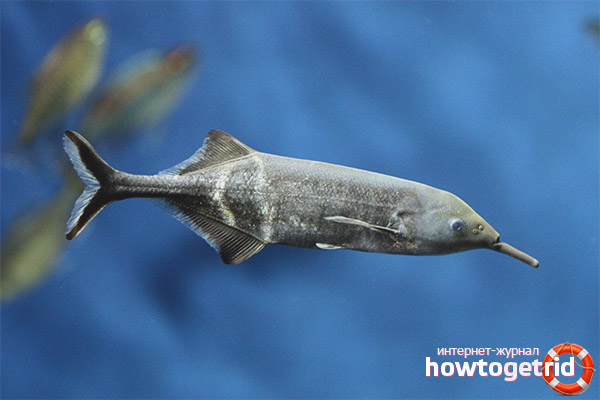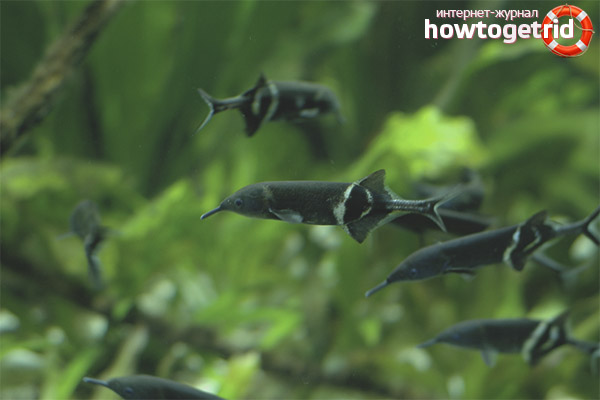The content of the article
The elephant fish got its name due to the presence of a trunk. The fish looks unusual and attracts attention, standing out against the general background of aquarium inhabitants. The lower lip resembles the trunk of an elephant, at the top there is a hole - the oral cavity. Water pets are famous for their interesting behavior, they can be observed for a very long time. Fish are inherently shy, do not like attention. But when they get used to the owner, they will become active and will be more often shown to the eyes.
Description
- Otherwise, the fish are called Nile elephants, they are common in African countries. The trunk is necessary for fish to search for food, with its help they dig up the soil when they live at the bottom. The main feature of the representatives of this family is that they form around them a weak electromagnetic field.
- Thanks to this, the fish can communicate and understand each other, as well as navigate among the entire surrounding space. Fish feed on insects, their larvae, invertebrates and vegetation. In general, elephant fish eat everything that they can find in the ground.
- Fish belong to medium-sized individuals; they can reach 20 cm in length. However, aquatic animals living in aquarium conditions do not grow so large. Captivity partially limits their growth. As for life expectancy, fish exist for at least 15 years. Cases were recorded when the elephant fish lived 25 years.
- The trunk is considered the most remarkable in the appearance of the pet. It is considered an important organ, without which the fish would not be itself. The trunk is located on the lower lip, it is required for food searches. A rounded oral cavity is located above the proboscis. The elephants are unremarkable in color, they are brownish-black, there are faded stripes located in the tail region.
- Fish are very rare, so many contain them incorrectly. The soil must be soft so that the fish does not damage the trunk when it searches for food. Pets need dim lighting; it is in such an environment that they live in nature.
- Fish that are sensitive to water parameters can feel bad if temperature or acidity starts to jump. Pets have an electromagnetic field that helps them communicate and navigate in the aquatic environment. Also, electric charges help elephants look for a companion.
Content
- Despite the fact that the fish are medium-sized, they guard their territory constantly. 150 l are allocated for one fish. water. Experts with experience advise keeping at least 4 elephants. So they will reveal their essence and be more active.
- Water inhabitants can easily get out of the tank, so cover the aquarium with glass or a transparent lid. They prefer to stay awake in the evening and at night. But when they get used to the new environment, they will be active during the day. The aquarium should not be too brightly lit, otherwise it will be difficult for the fish.
- All that the family needs is twilight, shelters, vegetation, a stable aquatic environment, a place for swimming and soft ground. Fish are not indifferent to pipes open from all sides.
- Water temperature should be in the range of 25-28 degrees. In this case, special attention is paid to stiffness - 6-14 units, acidity - 6-7.5 units. It is a mistake to believe that elephants are being salted. They are freshwater inhabitants, so salt is not added.
- The considered individuals are very sensitive to changes in water parameters. It is precisely because of such a feature of these fish that it is not recommended to start them for beginners. Also, if you are unable to maintain stable performance in the aquarium, this species should not be kept.
- Elephant fish are particularly sensitive to nitrates and ammonia in water. Such harmful substances are often found in the ground. The problem is that the fish in question live in the lower layers of the aquarium. It is imperative to install an external high-power filter.
- Siphon the bottom weekly and change the water. Closely monitor nitrate and ammonia levels in the medium. The use of sand is strongly recommended. The considered individuals love to bury themselves in it. The problem is that coarse soil can damage the body or trunk of the fish. Keep this in mind when decorating.
- As for the content in general terms, it is rather complicated. Elephant fish need almost ideal environmental indicators. The problem is that such conditions are very difficult to maintain. The considered individuals are very sensitive to any changes. In addition, the fish need to carefully select their neighbors. Need a special diet.
Feeding
- Elephant fish is unique in all respects. In the wild, she searches for food with the help of a trunk and an electric field. Often such individuals prefer worms, insects and all kinds of larvae. During the search, the fish skillfully wield their trunk, climbing into inaccessible places.
- As in the wild, it is recommended to feed the elephants in the aquarium with a tubulator, bloodworm or insects. Also, fish are very fond of worms. Do not forget that individuals lead a bottom lifestyle, so they will eat exclusively from the bottom.
- In some cases, the individuals in question eat cereal and fresh-frozen food. Elephants are most active at night. Keep in mind that fish should preferably be fed live food.
Keep in mind that when feeding elephants are not particularly active. The procedure is quite slow. That is why they should not be kept with more active fish. As for the general content. Then everything is quite complicated. It is not necessary to start the considered individuals if you do not have the proper experience. The maintenance of elephants requires responsibility and certain knowledge.
Video: elephant fish (Gnathonemus petersii)












Submit